

India is facing an unprecedented water crisis. With a growing population, industrialization, and climate change, the demand for water is increasing while the supply is decreasing. According to the NITI Aayog, by 2020, 21 major Indian cities will run out of groundwater, affecting 100 million people. Furthermore, water scarcity is already affecting agriculture, which accounts for 80% of India’s water consumption.
Treating Wastewater
One solution to India’s water crisis is to treat and reuse wastewater. Wastewater from cities is a significant source of pollution and can harm both human health and the environment. However, by treating wastewater, we can reduce pollution and create a new source of water.
Wastewater treatment involves several stages, including primary treatment, secondary treatment, and tertiary treatment. Primary treatment involves removing large solids and debris, while secondary treatment removes organic matter and nutrients. Tertiary treatment is the final stage, which removes remaining pollutants and disinfects the water.
Benefits of using treated wastewater
Treated wastewater has several benefits over freshwater sources. Firstly, it is available throughout the year, regardless of the season or rainfall patterns. This means that it can support agricultural activities in both dry and wet seasons, increasing crop yields and food security. Secondly, treated wastewater is less expensive than freshwater sources, as it requires less energy and infrastructure to extract, treat, and transport. Finally, treated wastewater can reduce the pollution of rivers, lakes, and groundwater sources, which can have significant environmental and public health benefits.
Channeling Treated Wastewater to Irrigation
Once wastewater is treated, it can be used for irrigation. This can help to reduce the demand for freshwater, which can then be used for other purposes. Moreover, treated wastewater is rich in nutrients and can improve soil quality, leading to higher crop yields.
In India, several initiatives have been taken to promote the use of treated wastewater for irrigation. For example, the Telangana state government has launched the “Mission Kakatiya” program, which aims to rejuvenate and restore irrigation tanks and water bodies in the state. As part of this program, treated wastewater is being used to fill up these tanks, which can then be used for irrigation purposes.
Similarly, in the city of Chennai, the Chennai Metropolitan Water Supply and Sewerage Board (CMWSSB) has set up a tertiary treatment plant to treat wastewater. The treated wastewater is then used for irrigation in nearby farmlands. The initiative has been successful in reducing the demand for freshwater and improving crop yields.
In addition to this, the use of treated wastewater for irrigation has also been promoted by the Indian government’s National Water Mission. The mission aims to increase the use of treated wastewater for non-potable purposes such as irrigation, industrial cooling, and firefighting.


